STRUCTURING PARAGRAPHS AND SENTENCES THE AIMS ARE

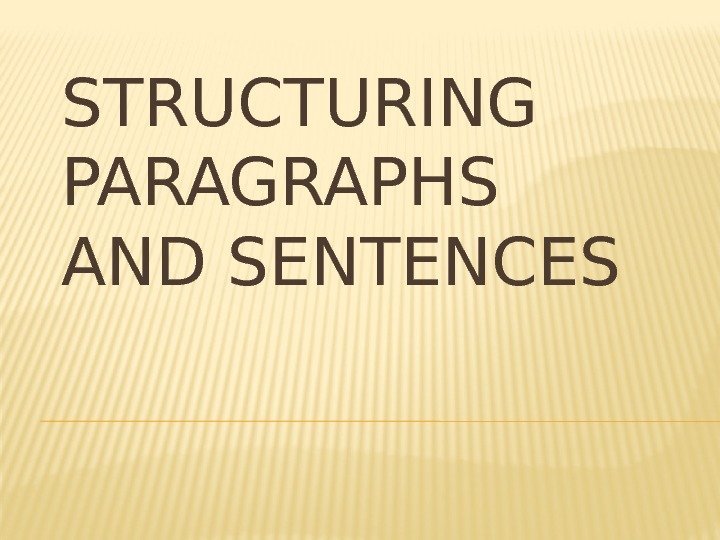
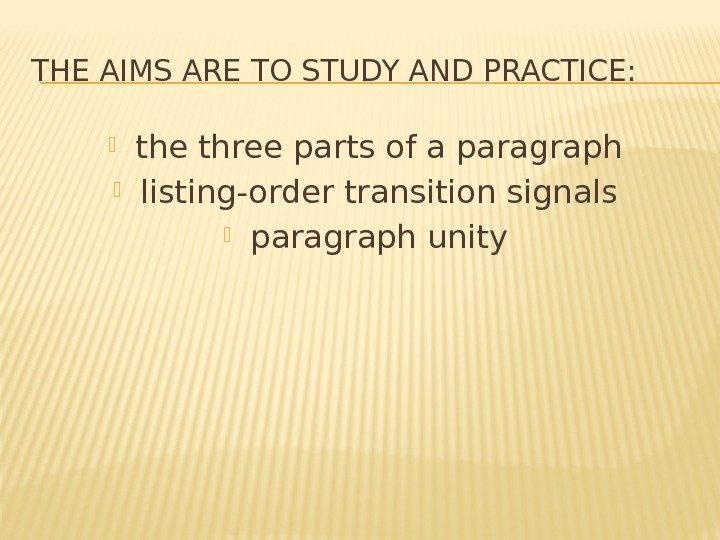
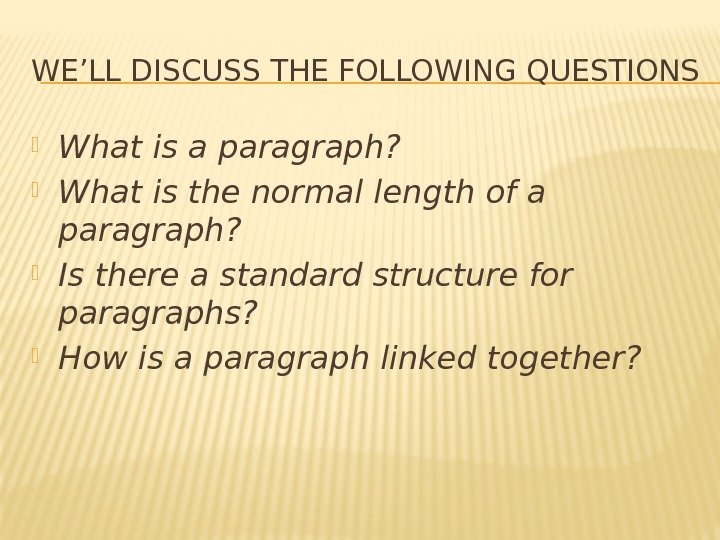
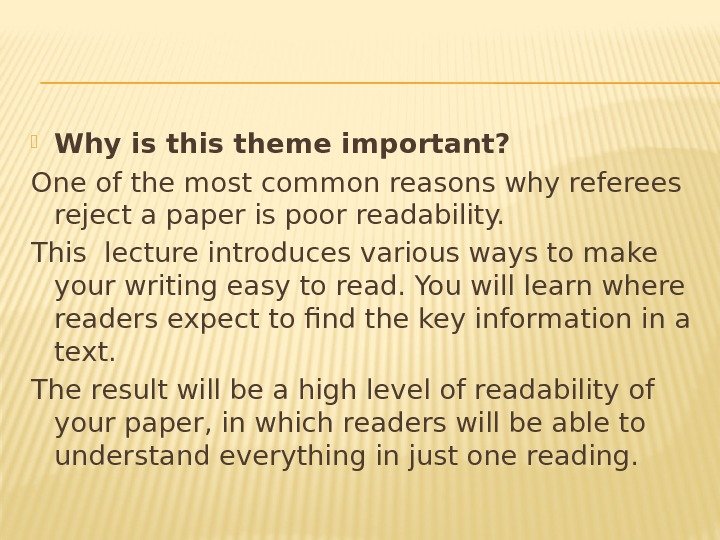
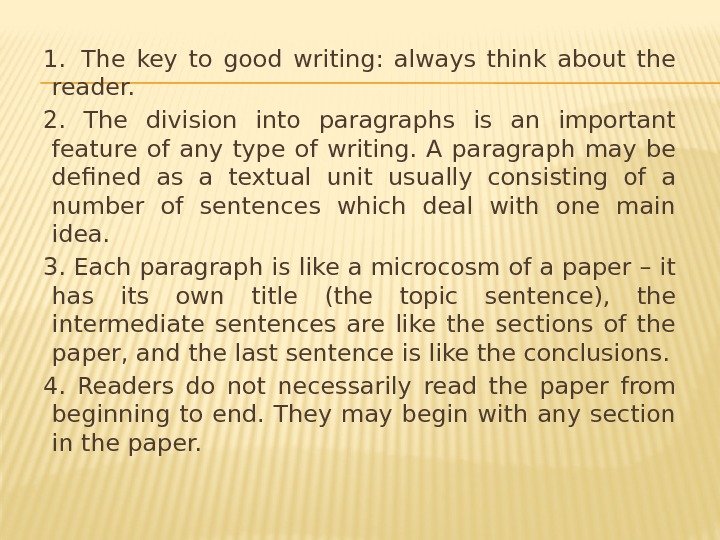
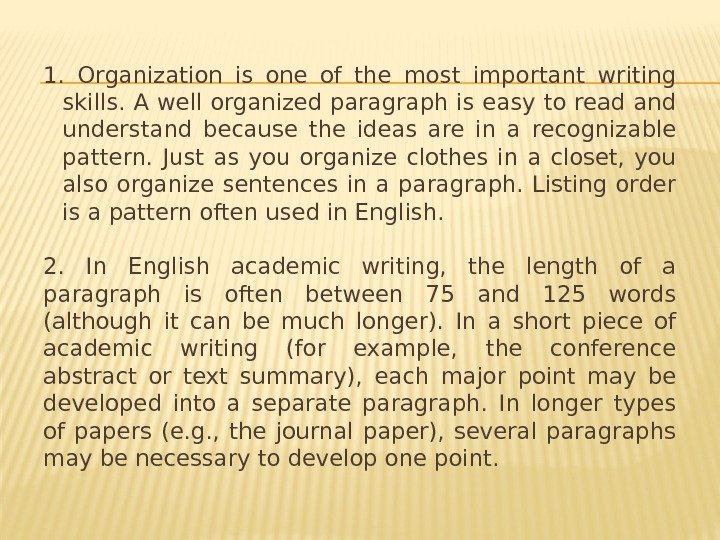
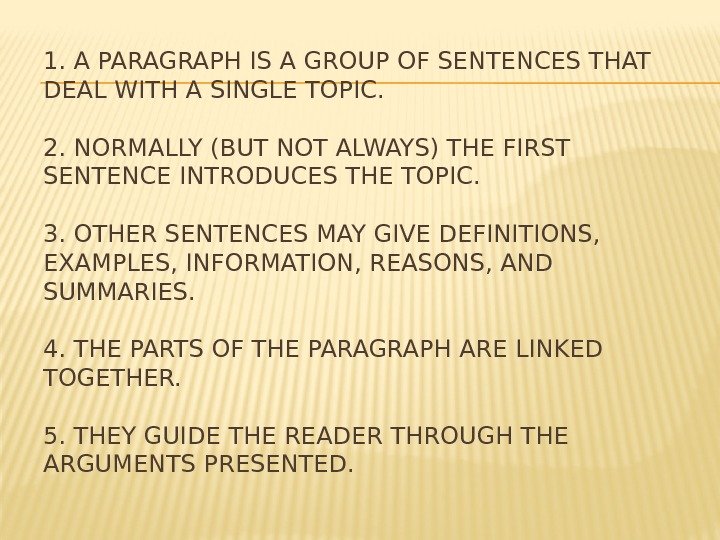
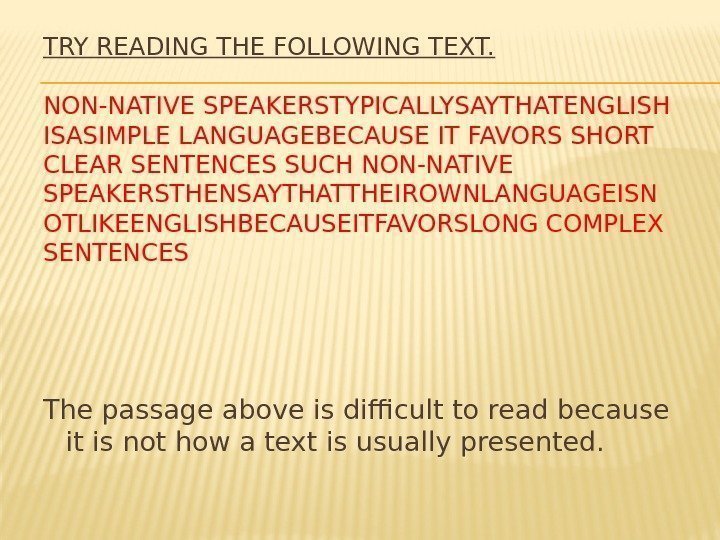
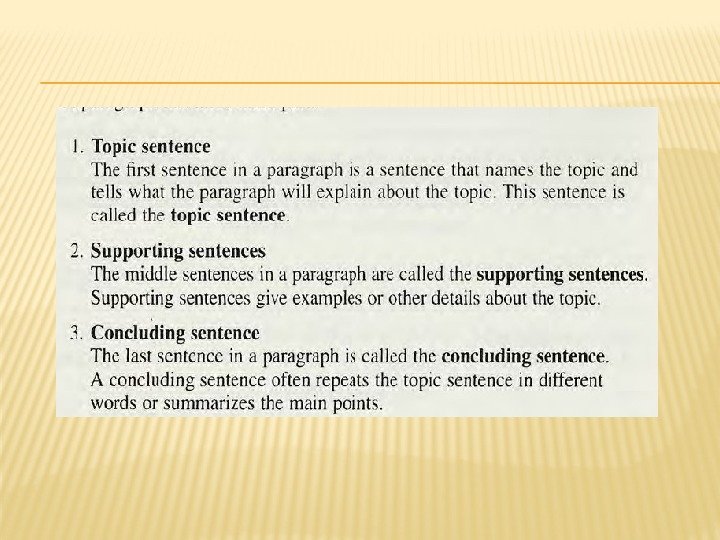
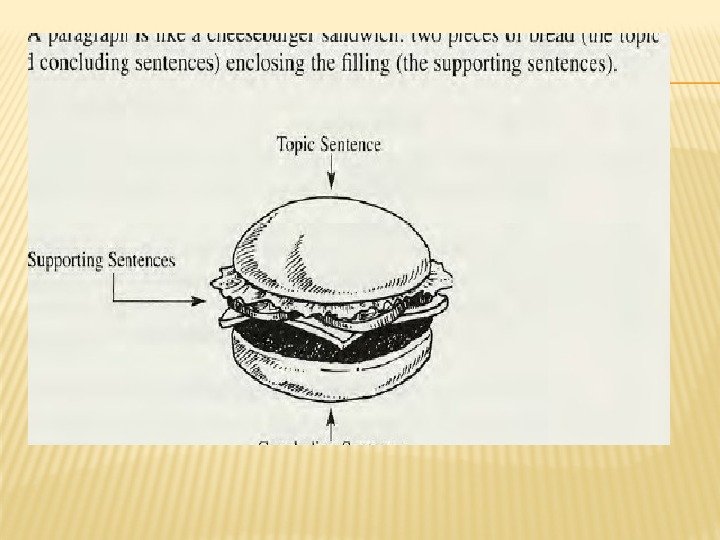
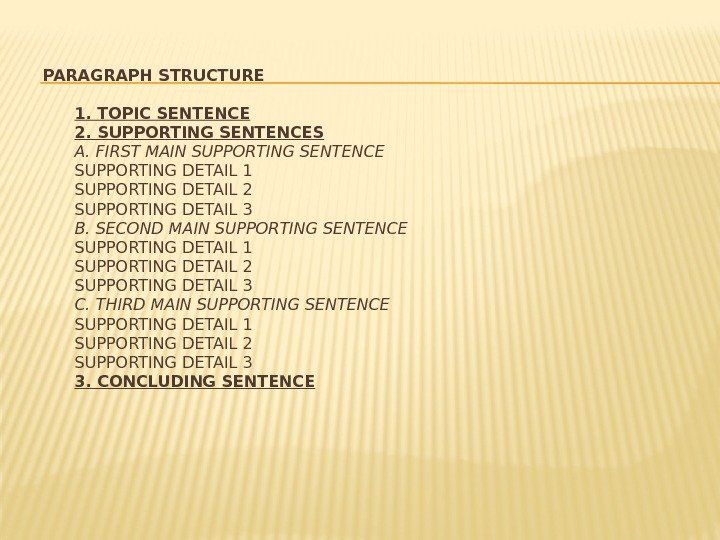
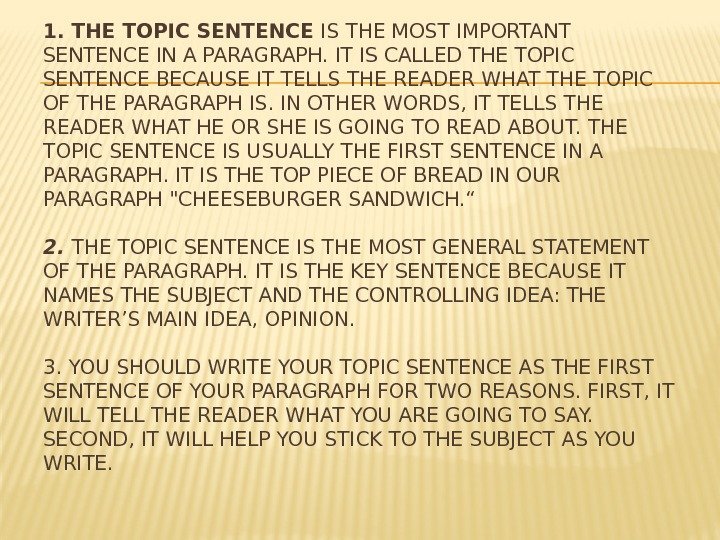
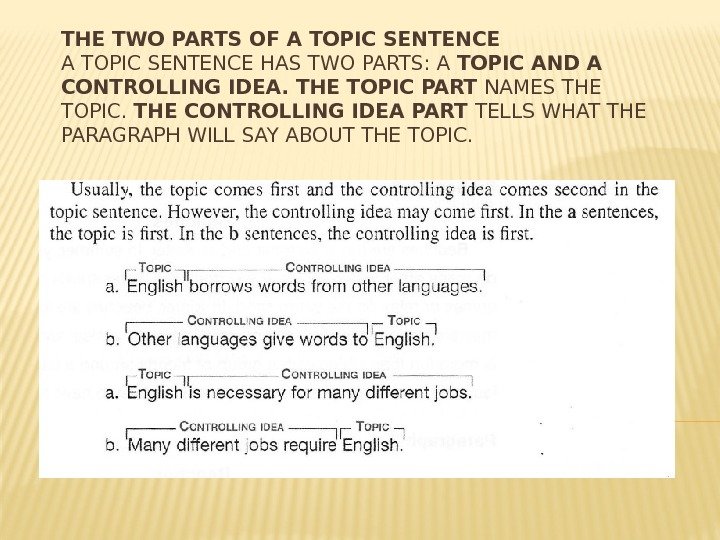
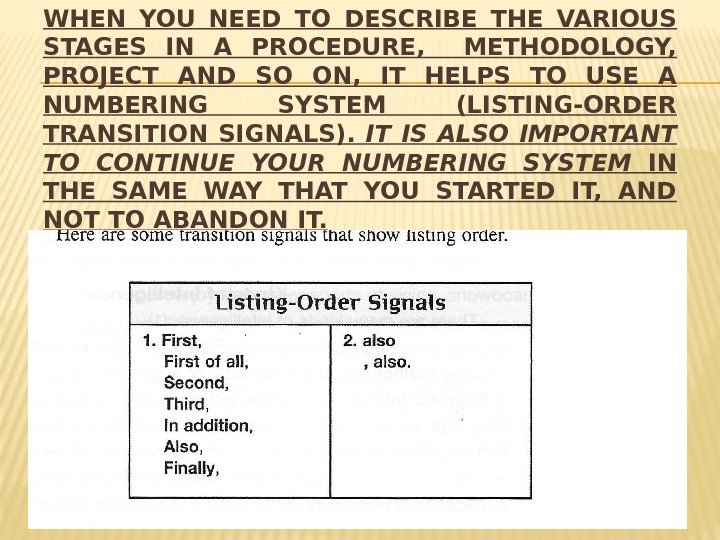
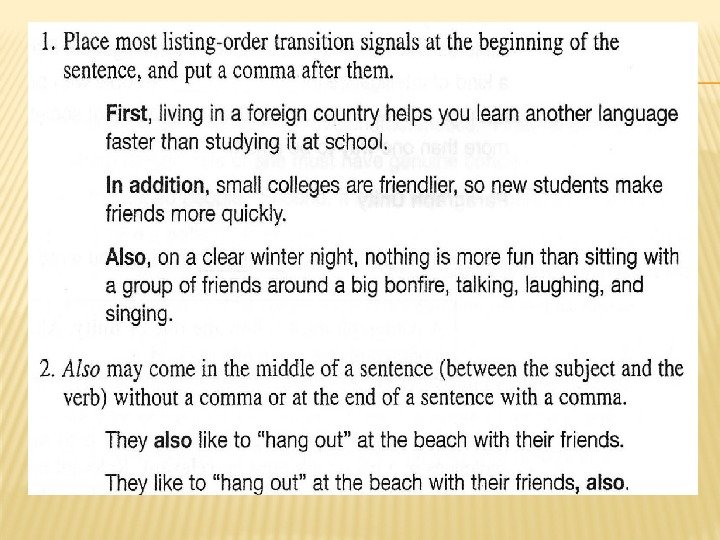
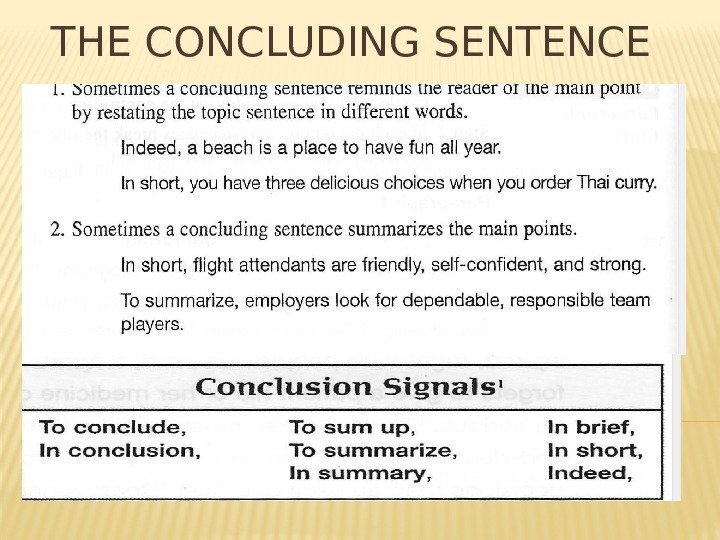
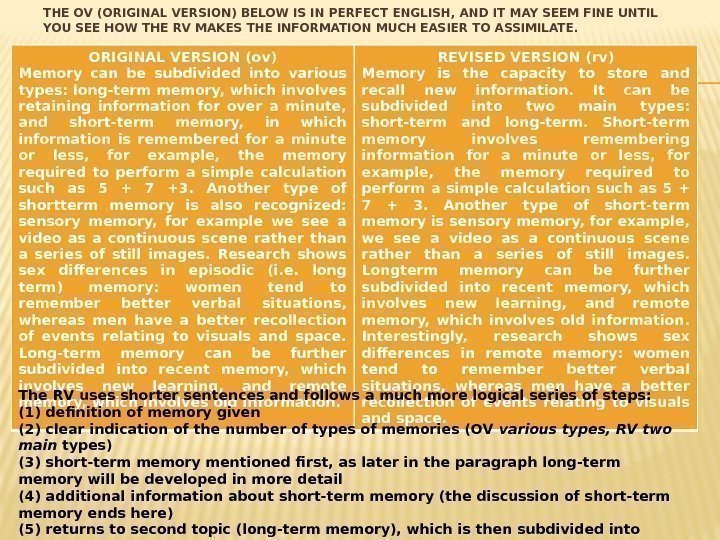
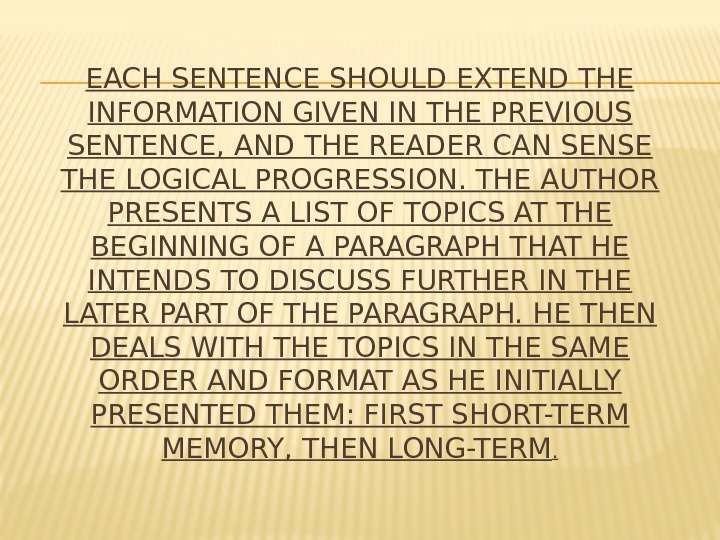
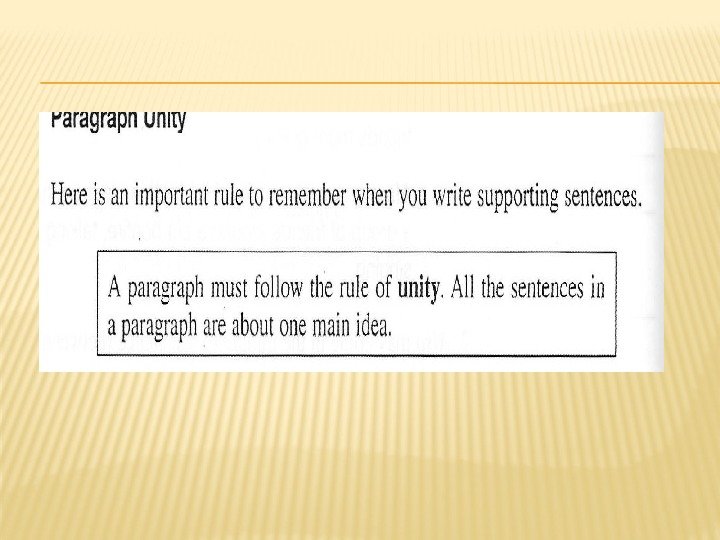
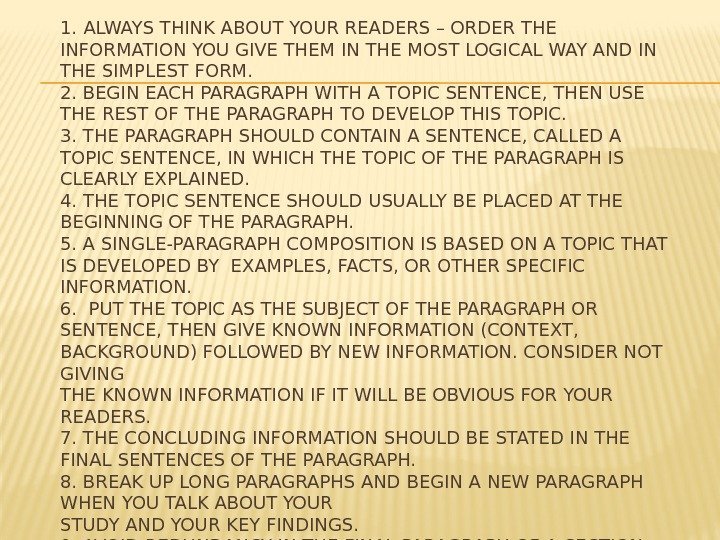
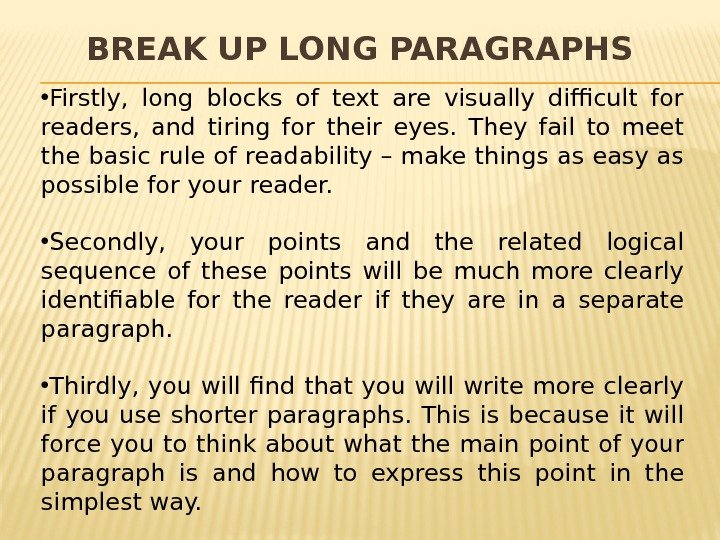
prezentaciya_3.pptx
- Размер: 4.8 Мб
- Автор:
- Количество слайдов: 21
Описание презентации STRUCTURING PARAGRAPHS AND SENTENCES THE AIMS ARE по слайдам
 STRUCTURING PARAGRAPHS AND SENTENCES
STRUCTURING PARAGRAPHS AND SENTENCES
 THE AIMS ARE TO STUDY AND PRACTICE: the three parts of a paragraph listing-order transition signals paragraph unity
THE AIMS ARE TO STUDY AND PRACTICE: the three parts of a paragraph listing-order transition signals paragraph unity
 WE’LL DISCUSS THE FOLLOWING QUESTIONS What is a paragraph? What is the normal length of a paragraph? Is there a standard structure for paragraphs? How is a paragraph linked together?
WE’LL DISCUSS THE FOLLOWING QUESTIONS What is a paragraph? What is the normal length of a paragraph? Is there a standard structure for paragraphs? How is a paragraph linked together?
 Why is theme important? One of the most common reasons why referees reject a paper is poor readability. This lecture introduces various ways to make your writing easy to read. You will learn where readers expect to find the key information in a text. The result will be a high level of readability of your paper, in which readers will be able to understand everything in just one reading.
Why is theme important? One of the most common reasons why referees reject a paper is poor readability. This lecture introduces various ways to make your writing easy to read. You will learn where readers expect to find the key information in a text. The result will be a high level of readability of your paper, in which readers will be able to understand everything in just one reading.
 1. The key to good writing: always think about the reader. 2. The division into paragraphs is an important feature of any type of writing. A paragraph may be defined as a textual unit usually consisting of a number of sentences which deal with one main idea. 3. Each paragraph is like a microcosm of a paper – it has its own title (the topic sentence), the intermediate sentences are like the sections of the paper, and the last sentence is like the conclusions. 4. Readers do not necessarily read the paper from beginning to end. They may begin with any section in the paper.
1. The key to good writing: always think about the reader. 2. The division into paragraphs is an important feature of any type of writing. A paragraph may be defined as a textual unit usually consisting of a number of sentences which deal with one main idea. 3. Each paragraph is like a microcosm of a paper – it has its own title (the topic sentence), the intermediate sentences are like the sections of the paper, and the last sentence is like the conclusions. 4. Readers do not necessarily read the paper from beginning to end. They may begin with any section in the paper.
 1. Organization is one of the most important writing skills. A well organized paragraph is easy to read and understand because the ideas are in a recognizable pattern. Just as you organize clothes in a closet, you also organize sentences in a paragraph. Listing order is a pattern often used in English. 2. In English academic writing, the length of a paragraph is often between 75 and 125 words (although it can be much longer). In a short piece of academic writing (for example, the conference abstract or text summary), each major point may be developed into a separate paragraph. In longer types of papers (e. g. , the journal paper), several paragraphs may be necessary to develop one point.
1. Organization is one of the most important writing skills. A well organized paragraph is easy to read and understand because the ideas are in a recognizable pattern. Just as you organize clothes in a closet, you also organize sentences in a paragraph. Listing order is a pattern often used in English. 2. In English academic writing, the length of a paragraph is often between 75 and 125 words (although it can be much longer). In a short piece of academic writing (for example, the conference abstract or text summary), each major point may be developed into a separate paragraph. In longer types of papers (e. g. , the journal paper), several paragraphs may be necessary to develop one point.
 1. A PARAGRAPH IS A GROUP OF SENTENCES THAT DEAL WITH A SINGLE TOPIC. 2. NORMALLY (BUT NOT ALWAYS) THE FIRST SENTENCE INTRODUCES THE TOPIC. 3. OTHER SENTENCES MAY GIVE DEFINITIONS, EXAMPLES, INFORMATION, REASONS, AND SUMMARIES. 4. THE PARTS OF THE PARAGRAPH ARE LINKED TOGETHER. 5. THEY GUIDE THE READER THROUGH THE ARGUMENTS PRESENTED.
1. A PARAGRAPH IS A GROUP OF SENTENCES THAT DEAL WITH A SINGLE TOPIC. 2. NORMALLY (BUT NOT ALWAYS) THE FIRST SENTENCE INTRODUCES THE TOPIC. 3. OTHER SENTENCES MAY GIVE DEFINITIONS, EXAMPLES, INFORMATION, REASONS, AND SUMMARIES. 4. THE PARTS OF THE PARAGRAPH ARE LINKED TOGETHER. 5. THEY GUIDE THE READER THROUGH THE ARGUMENTS PRESENTED.
 TRY READING THE FOLLOWING TEXT. NON-NATIVE SPEAKERSTYPICALLYSAYTHATENGLISH ISASIMPLE LANGUAGEBECAUSE IT FAVORS SHORT CLEAR SENTENCES SUCH NON-NATIVE SPEAKERSTHENSAYTHATTHEIROWNLANGUAGEISN OTLIKEENGLISHBECAUSEITFAVORSLONG COMPLEX SENTENCES The passage above is difficult to read because it is not how a text is usually presented.
TRY READING THE FOLLOWING TEXT. NON-NATIVE SPEAKERSTYPICALLYSAYTHATENGLISH ISASIMPLE LANGUAGEBECAUSE IT FAVORS SHORT CLEAR SENTENCES SUCH NON-NATIVE SPEAKERSTHENSAYTHATTHEIROWNLANGUAGEISN OTLIKEENGLISHBECAUSEITFAVORSLONG COMPLEX SENTENCES The passage above is difficult to read because it is not how a text is usually presented.


 PARAGRAPH STRUCTURE 1. TOPIC SENTENCE 2. SUPPORTING SENTENCES А. FIRST MAIN SUPPORTING SENTENCE SUPPORTING DETAIL 1 SUPPORTING DETAIL 2 SUPPORTING DETAIL 3 В. SECOND MAIN SUPPORTING SENTENCE SUPPORTING DETAIL 1 SUPPORTING DETAIL 2 SUPPORTING DETAIL 3 С. THIRD MAIN SUPPORTING SENTENCE SUPPORTING DETAIL 1 SUPPORTING DETAIL 2 SUPPORTING DETAIL 3 3. CONCLUDING SENTEN
PARAGRAPH STRUCTURE 1. TOPIC SENTENCE 2. SUPPORTING SENTENCES А. FIRST MAIN SUPPORTING SENTENCE SUPPORTING DETAIL 1 SUPPORTING DETAIL 2 SUPPORTING DETAIL 3 В. SECOND MAIN SUPPORTING SENTENCE SUPPORTING DETAIL 1 SUPPORTING DETAIL 2 SUPPORTING DETAIL 3 С. THIRD MAIN SUPPORTING SENTENCE SUPPORTING DETAIL 1 SUPPORTING DETAIL 2 SUPPORTING DETAIL 3 3. CONCLUDING SENTEN
 1. THE TOPIC SENTENCE IS THE MOST IMPORTANT SENTENCE IN A PARAGRAPH. IT IS CALLED THE TOPIC SENTENCE BECAUSE IT TELLS THE READER WHAT THE TOPIC OF THE PARAGRAPH IS. IN OTHER WORDS, IT TELLS THE READER WHAT HE OR SHE IS GOING TO READ ABOUT. THE TOPIC SENTENCE IS USUALLY THE FIRST SENTENCE IN A PARAGRAPH. IT IS THE TOP PIECE OF BREAD IN OUR PARAGRAPH «CHEESEBURGER SANDWICH. “ 2. THE TOPIC SENTENCE IS THE MOST GENERAL STATEMENT OF THE PARAGRAPH. IT IS THE KEY SENTENCE BECAUSE IT NAMES THE SUBJECT AND THE CONTROLLING IDEA: THE WRITER’S MAIN IDEA, OPINION. 3. YOU SHOULD WRITE YOUR TOPIC SENTENCE AS THE FIRST SENTENCE OF YOUR PARAGRAPH FOR TWO REASONS. FIRST, IT WILL TELL THE READER WHAT YOU ARE GOING TO SAY. SECOND, IT WILL HELP YOU STICK TO THE SUBJECT AS YOU WRITE.
1. THE TOPIC SENTENCE IS THE MOST IMPORTANT SENTENCE IN A PARAGRAPH. IT IS CALLED THE TOPIC SENTENCE BECAUSE IT TELLS THE READER WHAT THE TOPIC OF THE PARAGRAPH IS. IN OTHER WORDS, IT TELLS THE READER WHAT HE OR SHE IS GOING TO READ ABOUT. THE TOPIC SENTENCE IS USUALLY THE FIRST SENTENCE IN A PARAGRAPH. IT IS THE TOP PIECE OF BREAD IN OUR PARAGRAPH «CHEESEBURGER SANDWICH. “ 2. THE TOPIC SENTENCE IS THE MOST GENERAL STATEMENT OF THE PARAGRAPH. IT IS THE KEY SENTENCE BECAUSE IT NAMES THE SUBJECT AND THE CONTROLLING IDEA: THE WRITER’S MAIN IDEA, OPINION. 3. YOU SHOULD WRITE YOUR TOPIC SENTENCE AS THE FIRST SENTENCE OF YOUR PARAGRAPH FOR TWO REASONS. FIRST, IT WILL TELL THE READER WHAT YOU ARE GOING TO SAY. SECOND, IT WILL HELP YOU STICK TO THE SUBJECT AS YOU WRITE.
 THE TWO PARTS OF A TOPIC SENTENCE HAS TWO PARTS: A TOPIC AND A CONTROLLING IDEA. THE TOPIC PART NAMES THE TOPIC. THE CONTROLLING IDEA PART TELLS WHAT THE PARAGRAPH WILL SAY ABOUT THE TOPIC.
THE TWO PARTS OF A TOPIC SENTENCE HAS TWO PARTS: A TOPIC AND A CONTROLLING IDEA. THE TOPIC PART NAMES THE TOPIC. THE CONTROLLING IDEA PART TELLS WHAT THE PARAGRAPH WILL SAY ABOUT THE TOPIC.
 WHEN YOU NEED TO DESCRIBE THE VARIOUS STAGES IN A PROCEDURE, METHODOLOGY, PROJECT AND SO ON, IT HELPS TO USE A NUMBERING SYSTEM (LISTING-ORDER TRANSITION SIGNALS). IT IS ALSO IMPORTANT TO CONTINUE YOUR NUMBERING SYSTEM IN THE SAME WAY THAT YOU STARTED IT, AND NOT TO ABANDON IT.
WHEN YOU NEED TO DESCRIBE THE VARIOUS STAGES IN A PROCEDURE, METHODOLOGY, PROJECT AND SO ON, IT HELPS TO USE A NUMBERING SYSTEM (LISTING-ORDER TRANSITION SIGNALS). IT IS ALSO IMPORTANT TO CONTINUE YOUR NUMBERING SYSTEM IN THE SAME WAY THAT YOU STARTED IT, AND NOT TO ABANDON IT.

 THE CONCLUDING SENTEN
THE CONCLUDING SENTEN
 THE OV (ORIGINAL VERSION) BELOW IS IN PERFECT ENGLISH, AND IT MAY SEEM FINE UNTIL YOU SEE HOW THE RV MAKES THE INFORMATION MUCH EASIER TO ASSIMILATE. ORIGINAL VERSION (ov) Memory can be subdivided into various types: long-term memory, which involves retaining information for over a minute, and short-term memory, in which information is remembered for a minute or less, for example, the memory required to perform a simple calculation such as 5 + 7 +3. Another type of shortterm memory is also recognized: sensory memory, for example we see a video as a continuous scene rather than a series of still images. Research shows sex differences in episodic (i. e. long term) memory: women tend to remember better verbal situations, whereas men have a better recollection of events relating to visuals and space. Long-term memory can be further subdivided into recent memory, which involves new learning, and remote memory, which involves old information. REVISED VERSION (rv) Memory is the capacity to store and recall new information. It can be subdivided into two main types: short-term and long-term. Short-term memory involves remembering information for a minute or less, for example, the memory required to perform a simple calculation such as 5 + 7 + 3. Another type of short-term memory is sensory memory, for example, we see a video as a continuous scene rather than a series of still images. Longterm memory can be further subdivided into recent memory, which involves new learning, and remote memory, which involves old information. Interestingly, research shows sex differences in remote memory: women tend to remember better verbal situations, whereas men have a better recollection of events relating to visuals and space. The RV uses shorter sentences and follows a much more logical series of steps: (1) definition of memory given (2) clear indication of the number of types of memories (OV various types, RV two main types) (3) short-term memory mentioned first, as later in the paragraph long-term memory will be developed in more detail (4) additional information about short-term memory (the discussion of short-term memory ends here) (5) returns to second topic (long-term memory), which is then subdivided into recent and remote (6) interesting fact about remote memory
THE OV (ORIGINAL VERSION) BELOW IS IN PERFECT ENGLISH, AND IT MAY SEEM FINE UNTIL YOU SEE HOW THE RV MAKES THE INFORMATION MUCH EASIER TO ASSIMILATE. ORIGINAL VERSION (ov) Memory can be subdivided into various types: long-term memory, which involves retaining information for over a minute, and short-term memory, in which information is remembered for a minute or less, for example, the memory required to perform a simple calculation such as 5 + 7 +3. Another type of shortterm memory is also recognized: sensory memory, for example we see a video as a continuous scene rather than a series of still images. Research shows sex differences in episodic (i. e. long term) memory: women tend to remember better verbal situations, whereas men have a better recollection of events relating to visuals and space. Long-term memory can be further subdivided into recent memory, which involves new learning, and remote memory, which involves old information. REVISED VERSION (rv) Memory is the capacity to store and recall new information. It can be subdivided into two main types: short-term and long-term. Short-term memory involves remembering information for a minute or less, for example, the memory required to perform a simple calculation such as 5 + 7 + 3. Another type of short-term memory is sensory memory, for example, we see a video as a continuous scene rather than a series of still images. Longterm memory can be further subdivided into recent memory, which involves new learning, and remote memory, which involves old information. Interestingly, research shows sex differences in remote memory: women tend to remember better verbal situations, whereas men have a better recollection of events relating to visuals and space. The RV uses shorter sentences and follows a much more logical series of steps: (1) definition of memory given (2) clear indication of the number of types of memories (OV various types, RV two main types) (3) short-term memory mentioned first, as later in the paragraph long-term memory will be developed in more detail (4) additional information about short-term memory (the discussion of short-term memory ends here) (5) returns to second topic (long-term memory), which is then subdivided into recent and remote (6) interesting fact about remote memory
 EACH SENTENCE SHOULD EXTEND THE INFORMATION GIVEN IN THE PREVIOUS SENTENCE, AND THE READER CAN SENSE THE LOGICAL PROGRESSION. THE AUTHOR PRESENTS A LIST OF TOPICS AT THE BEGINNING OF A PARAGRAPH THAT HE INTENDS TO DISCUSS FURTHER IN THE LATER PART OF THE PARAGRAPH. HE THEN DEALS WITH THE TOPICS IN THE SAME ORDER AND FORMAT AS HE INITIALLY PRESENTED THEM: FIRST SHORT-TERM MEMORY, THEN LONG-TERM.
EACH SENTENCE SHOULD EXTEND THE INFORMATION GIVEN IN THE PREVIOUS SENTENCE, AND THE READER CAN SENSE THE LOGICAL PROGRESSION. THE AUTHOR PRESENTS A LIST OF TOPICS AT THE BEGINNING OF A PARAGRAPH THAT HE INTENDS TO DISCUSS FURTHER IN THE LATER PART OF THE PARAGRAPH. HE THEN DEALS WITH THE TOPICS IN THE SAME ORDER AND FORMAT AS HE INITIALLY PRESENTED THEM: FIRST SHORT-TERM MEMORY, THEN LONG-TERM.

 SUMMARY 1. ALWAYS THINK ABOUT YOUR READERS – ORDER THE INFORMATION YOU GIVE THEM IN THE MOST LOGICAL WAY AND IN THE SIMPLEST FORM. 2. BEGIN EACH PARAGRAPH WITH A TOPIC SENTENCE, THEN USE THE REST OF THE PARAGRAPH TO DEVELOP THIS TOPIC. 3. THE PARAGRAPH SHOULD CONTAIN A SENTENCE, CALLED A TOPIC SENTENCE, IN WHICH THE TOPIC OF THE PARAGRAPH IS CLEARLY EXPLAINED. 4. THE TOPIC SENTENCE SHOULD USUALLY BE PLACED AT THE BEGINNING OF THE PARAGRAPH. 5. A SINGLE-PARAGRAPH COMPOSITION IS BASED ON A TOPIC THAT IS DEVELOPED BY EXAMPLES, FACTS, OR OTHER SPECIFIC INFORMATION. 6. PUT THE TOPIC AS THE SUBJECT OF THE PARAGRAPH OR SENTENCE, THEN GIVE KNOWN INFORMATION (CONTEXT, BACKGROUND) FOLLOWED BY NEW INFORMATION. CONSIDER NOT GIVING THE KNOWN INFORMATION IF IT WILL BE OBVIOUS FOR YOUR READERS. 7. THE CONCLUDING INFORMATION SHOULD BE STATED IN THE FINAL SENTENCES OF THE PARAGRAPH. 8. BREAK UP LONG PARAGRAPHS AND BEGIN A NEW PARAGRAPH WHEN YOU TALK ABOUT YOUR STUDY AND YOUR KEY FINDINGS. 9. AVOID REDUNDANCY IN THE FINAL PARAGRAPH OF A SECTION.
SUMMARY 1. ALWAYS THINK ABOUT YOUR READERS – ORDER THE INFORMATION YOU GIVE THEM IN THE MOST LOGICAL WAY AND IN THE SIMPLEST FORM. 2. BEGIN EACH PARAGRAPH WITH A TOPIC SENTENCE, THEN USE THE REST OF THE PARAGRAPH TO DEVELOP THIS TOPIC. 3. THE PARAGRAPH SHOULD CONTAIN A SENTENCE, CALLED A TOPIC SENTENCE, IN WHICH THE TOPIC OF THE PARAGRAPH IS CLEARLY EXPLAINED. 4. THE TOPIC SENTENCE SHOULD USUALLY BE PLACED AT THE BEGINNING OF THE PARAGRAPH. 5. A SINGLE-PARAGRAPH COMPOSITION IS BASED ON A TOPIC THAT IS DEVELOPED BY EXAMPLES, FACTS, OR OTHER SPECIFIC INFORMATION. 6. PUT THE TOPIC AS THE SUBJECT OF THE PARAGRAPH OR SENTENCE, THEN GIVE KNOWN INFORMATION (CONTEXT, BACKGROUND) FOLLOWED BY NEW INFORMATION. CONSIDER NOT GIVING THE KNOWN INFORMATION IF IT WILL BE OBVIOUS FOR YOUR READERS. 7. THE CONCLUDING INFORMATION SHOULD BE STATED IN THE FINAL SENTENCES OF THE PARAGRAPH. 8. BREAK UP LONG PARAGRAPHS AND BEGIN A NEW PARAGRAPH WHEN YOU TALK ABOUT YOUR STUDY AND YOUR KEY FINDINGS. 9. AVOID REDUNDANCY IN THE FINAL PARAGRAPH OF A SECTION.
 BREAK UP LONG PARAGRAPHS • Firstly, long blocks of text are visually difficult for readers, and tiring for their eyes. They fail to meet the basic rule of readability – make things as easy as possible for your reader. • Secondly, your points and the related logical sequence of these points will be much more clearly identifiable for the reader if they are in a separate paragraph. • Thirdly, you will find that you will write more clearly if you use shorter paragraphs. This is because it will force you to think about what the main point of your paragraph is and how to express this point in the simplest way.
BREAK UP LONG PARAGRAPHS • Firstly, long blocks of text are visually difficult for readers, and tiring for their eyes. They fail to meet the basic rule of readability – make things as easy as possible for your reader. • Secondly, your points and the related logical sequence of these points will be much more clearly identifiable for the reader if they are in a separate paragraph. • Thirdly, you will find that you will write more clearly if you use shorter paragraphs. This is because it will force you to think about what the main point of your paragraph is and how to express this point in the simplest way.

